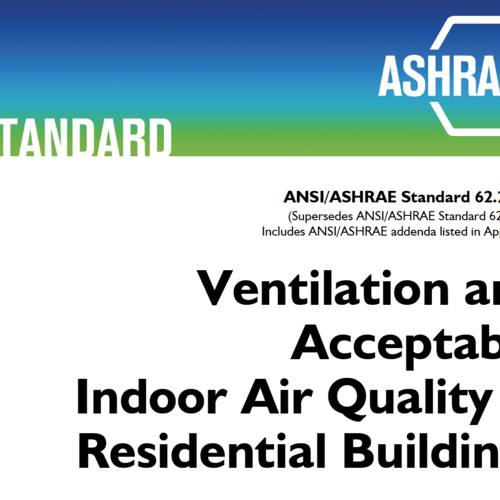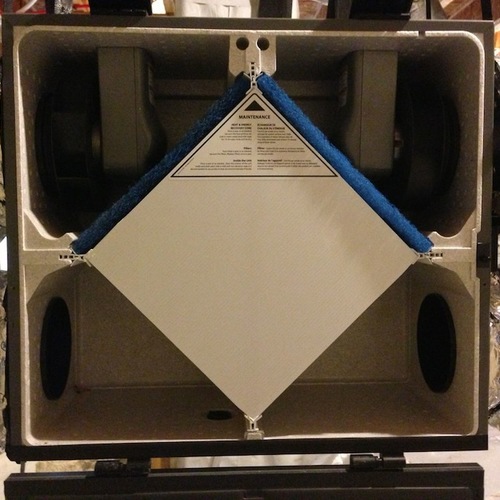Image Credit: Nate Adams
Image Credit: Nate Adams The room was packed for the Great Ventilation Standard Debate at the Affordable Comfort conference in Detroit last week.
Image Credit: Bethany Profaizer
Last week at the Affordable Comfort Conference (also known as ACI), I co-moderated a panel called The Great Ventilation Standard Debate.1 Duncan Prahl of Ibacos proposed the session and rounded up a collection of some of best building science folks in North America to be on the panel. And if you’ve been paying attention to this blog, you know who one of them was.
The photo above (taken by Nate Adams) shows the cast of experts on the panel. From left to right, they are Joseph Lstiburek, PhD, PE, Iain Walker, PhD, Paul Francisco, Michael Lubliner, Rick Karg, and Don Stevens. All but Lstiburek are on the ASHRAE 62.2 committee. In addition, there were 3 or 4 other members of the 62.2 committee in the audience.
And speaking of the audience, we had a great crowd. I haven’t heard an official number, but it was probably 150 to 200. The photo below (taken by Bethany Profaizer) gives you a view from the back.
A brief history of the debate
I’ve written about the issue of mechanical ventilation and the ongoing debate several times over the past year and a half. Here’s the short version, with links to the articles I’ve written.
First, everyone agrees that airtight houses need mechanical ventilation. (Also not up for debate is that homes need to be airtight. A house does NOT need to breathe.) Since we agree that ventilation is necessary in airtight homes, we need some guidance on how to do that. “Build tight; ventilate right” is a great mantra, but that second part needs to be fleshed out.
That’s where ASHRAE comes in. They’ve got a ventilation standard for homes, and it’s gone through several updates since the 1989 version. Since 2003, it’s been called ASHRAE 62.2: Ventilation and Acceptable Indoor Air Quality in Low-Rise Residential Buildings. The standard covers a lot of ground, but at the heart of it is a method for determining the amount of ventilation air a home needs. And that’s where the debate begins.
Joseph Lstiburek, PhD, PE, has argued loudly against the way that rate is determined. His biggest complaints about 62.2 are that:
So Joe introduced his own standard last year – BSC-01. (It’s really more of a set of guidelines than a standard, though, because it hasn’t gone through a consensus process like 62.2 has.) BSC-01 is for new homes only and allows systems that are balanced, that distribute the air throughout the house, and that mix the air to run at lower rates.
The opening punches
We opened the panel discussion by asking each of the six panelists to introduce themselves and make an opening statement. The five 62.2 members were diplomatic in their words. Lstiburek opened by saying that 62.2 isn’t based on science, costs people money they don’t need to spend, and makes homes too dry in cold climates and too humid in humid climates. Further, he said, it’s worthless because no one is adopting it.
The discussion was civil throughout, although there were some pointed disagreements. Francisco talked about the justification for the rates and opened his comments by saying, “ASHRAE 62.2 is wrong 99% of the time for most homes.” He said the purpose of the standard is to recommend ventilation strategies that can do the most good for the most homes.
Francisco (or was it Walker?) referred to a study from Scandinavia that would justify even higher rates than we’re using now. Lstiburek jumped in at that point and said that study was wrong and the real takeaway from it wasn’t that we need higher rates but that we need to fix moisture problems before they become indoor air quality problems.
Rick Karg asked Lstiburek a few questions at one point in the discussion, one of which was, If you’re criticizing 62.2 rates for not being supported by the science, what science supports the rates you recommend? It was an excellent question, and Lstiburek didn’t have a good answer for it. (How I think he should have responded is that since there’s no health science to support either 62.2 or BSC-01 rates, we should do what causes the fewest problems.)
A serious problem with exhaust-only ventilation
The debate didn’t focus as much on the problems with exhaust-only ventilation as I thought it would, but Lstiburek did make a compelling point on that issue. In multifamily buildings, using bath fans and the kitchen range hood to satisfy 62.2 is nearly impossible to do effectively. “If the building is compartmentalized,” Lstiburek said, “good luck with makeup air. What are you going to do? Leave a window out?”
Hope for the future of 62.2
Francisco had the best line of the day. We asked the panelists all to make a closing statement and tell us where they see things going. When it was his turn, Francisco began, “I don’t know where we’re going, but I do know how we got in this handbasket.”
The debate at ACI was lively and interesting yet friendly. Lstiburek was laughing with Walker over private comments at one point, and the group found some things to agree about. The biggest point of agreement was that kitchen exhaust is really important, and we need range hoods with good capture efficiency, not just high ventilation rates. Francisco, the chair of the 62.2 committee, even called for a vote to document that agreement.
Toward the end of the discussion, Lstiburek made an announcement. “I’d like to get back on the committee, if you’ll have me,” he said. “I may have to beg and grovel, but I’d like to be a member again.”
Wrapup
It was a great discussion at the ACI conference by some of the most expert minds on the topic of ventilation. Both sides made good points. Both sides made bad points. We also had some great comments and questions from the audience, including one from a gentleman who works in weatherization of existing homes. When he has to add a ventilation system, he said, that means less money to improve the insulation, air-sealing, and HVAC system.
As he wrapped up the discussion, Duncan Prahl reminded everyone that the ASHRAE 62.2 committee members are all volunteers and that anyone can contribute to the evolution of the standard. It’s easy to criticize something you don’t like. It’s harder to get involved and make it better. My sense after this discussion is that the 62.2 standard is about to take the next steps forward and address some of the issues that led Lstiburek to go rogue last year.
Allison Bailes of Decatur, Georgia, is a speaker, writer, energy consultant, RESNET-certified trainer, and the author of the Energy Vanguard Blog. You can follow him on Twitter at @EnergyVanguard.
Weekly Newsletter
Get building science and energy efficiency advice, plus special offers, in your inbox.
















7 Comments
An Excellent Solution in Imminent
OK, more science is needed to determine flowrates. But every room in every house and every person is different. That means the cfm per room needs to be adjustable.
In heating, we automatically adjust the heat delivery with a bang-bang thermostat.
In IAQ, outside air delivery can be adjusted with an analogous IAQ control. This control needs to developed while the science determines the minimum setpoint for health.
In the meantime, we can install systems that are simply controlled with a timer or speed control. The timer is set by the homeowner, who can choose "economy", "maximum fresh air" or somewhere in between.
Lunos has developed an 85% HRV for individual rooms, a near perfect design that needs a quantum drop in price. It's extremely simple, using a core that looks like the business end of a $40 automotive catalytic converter. http://en.wikipedia.org/wiki/Catalyst_support
The Lunos e-go or a similar design will eventually retail for under $150 each, making it the standard way to ventilate since it eliminates ducting, commissioning, and provides perfect zoning. http://www.foursevenfive.com/index.php?main_page=product_info&cPath=70_71_98_99&products_id=329
The price can be driven down with incentives similar to the ones that helped the PV industry get to where it is now.
All we need from ASHRAE, then, is the minimum healthy setpoint. That research needs to come from the medical community, not building scientists.
Jin, reading you is
Jin, reading you is impossible. What is your occupation. Are you a builder? Years in building? Interested homeowner? What zone are you in?
AJ
i apologize for my writing, i cannot access GBA from home for some reason, so i do it from work
and it is a busy season so i do write in small sections and sometimes i loss track a bit ...that and my poor english syntax/grammar probably doesn't help.
My occupation is ... life of course :)
I am currently in a transitional zone !
Apprentice builder, designer, future architectural products manufacturer
and a very interested human in everything there is to learn.
but this is not about me AJ ... it's all about knowledge!
Kevin
I have also wondered for quite some time why nobody else came out with a similar setup
as the Lunos units, but cheaper .
The lunos is out of price for what it is, but the basic idea is great.
I do not believe we will see any similar units in the 150$ range,
but a less efficient unit for 3-500$ could be possible.
It is probably a question of controller and software more than the sum of the parts.
Installing a direct through wall unit in multiple bed rooms brings up the installation complexity and cost while not permiting the exhaust of contaminants from the kitchen nor excess humidity from the bathrooms .
Current ducted HRV have other downsides including expensive installation and ducting required,
but a single unit can send fresh air to multiple bed rooms.
Kitchen hoods do not capture 100% of the cooking byproducts,
probably more like 50% or less ..so there is a significant portion of fumes and toxic stuff left thwirling around in the kitchen air for a few hours after cooking is finished.
I posess very little knowledge on air exhcange rates and ASHRAE/BSC standards, but i intend to follow this closely in the coming years and i would be tempted to side with BSC on this one , since i am not personally interested in ventilation of existing/old buildings.
With the advancing efficiency of the newer HRVs ( 70-75%+ ),
excessive ventilation ( safe over margin ) poses less of an energy problem during time of year where the temperature difference from in/out is lesser than winter or hard summer.
How many CFM of fresh air does a human adult requires while sleeping ?
What about when awake ?
As many others, i had little interest in air infiltration rates and standards in the past because i then failed to realize the associated energy costs. Then i start learning about health issues and it only adds up to the growing interest.
edited
edited
Ventilation
A typical person breaths in 0.211 cubic feet per minute, that's sitting, and doing simple chores about the home.
As Kevin writes.
The typical HRV doesn't take into consideration the small amount of air we need, or the number of people in the home, or the location of the people. Obviously, you need each room with individual control, just like a decent hotel room, if you have introduced pollution into the home, or are having a party with lots of activity it makes sense to open a window or two. IAQ at the moment can be controlled for water vapor, other contaminants are too many and complex to control, in many instances outdoor air is also contaminated.
Exhaust ventilation, at a time when we are being encouraged to conserve energy it it makes little sense to pull masses of hot or cold air into our homes with the attendant cost of cooling and heating that fresh air.
Kitchen range air, it is correct that the majority of kitchens are not set up to supply make up air, mostly the air is pulled from other parts of the home, yet there is a simple solution, a vent in the wall placed close behind the range, of a size able to supply all the required air, with suitable under counter ducting the air can be channelled to rise on all sides, thereby enabling the cooking smells and water vapor to escape through the wall, and importantly leaving the warm air untouched inside the kitchen. One needs to fit a door to keep out unwanted hot and cold air.
The Lunos e-go is probably the ideal piece of equipment to use in a bathroom as is Vent and a number of products made in Europe, they are not cheap.
Reply to Roger Anthony
"IAQ at the moment can be controlled for water vapor, other contaminants are too many and complex to control, in many instances outdoor air is also contaminated."
The manufacturers certainly have their work cut out. Codes already require alarms for smoke (particulates?) and carbon monoxide. An IAQ control would also sense for CO2, VOCs, humidity, and a maybe a few more that the needed science will discover. It would also control an indoor HEPA filter and sense for outdoor pollution. The particulate filter doesn't need a hole in the envelope.
An economical strategy for the kitchen could be a filtered draft hood that just dumps back into the space. The 27 cfm HRV will take an hour to replace the bad air that a 400cfm vent can do in 4 minutes. This may be acceptable, especially with all-electric cooking. Cooking with gas is not acceptable in a healthy house.
The bad stuff from cooking is H2O, CO2, CO, VOCs (mostly vaporized grease), particulates, and whatever else the science finds. The kitchen charcoal filtered draft hood knocks out the particulates and some of the bad gases instantly, while the HRVs catch up. This filter is in an easy and obvious place for maintenance. When it is clogged, the IAQ control will sense it. On low speed, it could double as the whole house HEPA filter.
Note that none of this measurement and control requires a cfm number from an ASHRAE committee. Those efforts should be re-directed to finding the the maximum values for the identified pollutants.
Log in or create an account to post a comment.
Sign up Log in